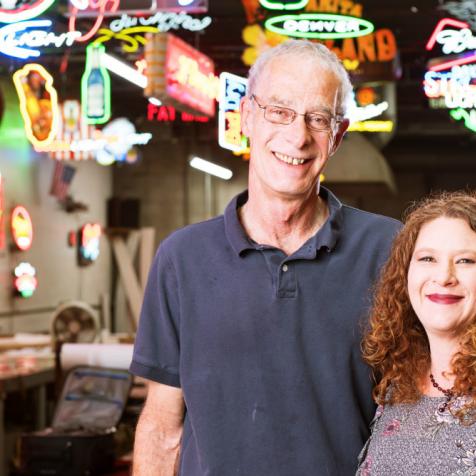
Company Details
Location
Denver, Colorado
Founded
1985
Ownership Type
Private
Employees
5
Products
Neon signs
Denver
Founded: 1985
Privately owned
Employees: 5
Industry: Built Environment
Products: Neon signs
Owner Glen Weseloh crafts custom signs that illuminate with the magic of neon.
Glen learned to create and restore neon signs from one of the best craftsmen in the business: his father, Morry.
"I had no idea that I'd continue [Morry's Neon Signs] after he was gone," says Glen of the business he founded in 1985 with his late father, who passed away in 2003. "But it gets in your blood."
Before opening his own shop, Morry worked for 40 years at other sign businesses in the Denver area. Some of his work included the beer sign for Lane's Tavern (now featured within the Lakewood Heritage Center), the neon at Union Station and Lakeside Amusement Park, and the Arby's signs on poles that dotted the Denver area.

Morry taught his son about the craft. Glen, who had previously run video stores, says, "It took me three years, before I could say I could do this. It took a lot practice: You have to heat the glass evenly, you have to know where to heat it, how much to heat it."
In the business' shop in an industrial park in central Denver, Glen and other workers take glass tubes, which have been specially-coated inside with, respectively, different colored phosphors, and heat them up over flames to around 900 degrees "to where [the glass is] just like jelly." Simultaneously, they blow into a tube attached to the glass, in order to prevent the diameter of the gas from changing. Glen and his crew bend the heated glass, matching it up against the pattern sketched onto a sheet of paper.

Next, electrodes are mounted on either end of the glass. Then, the tubes are primed with 22,000 volts of electricity to make the inside "as pure as possible," before being filled with either neon or argon gas. Filled tubes are hooked up to a smaller transformer, which "acclimates the gas within." When the assemblage of lights is completed and finally switched on, electricity travels from electrode to electrode 50 times a second, causing the gas to glow.
"We have manufactured and installed neon in over half of the United States," says Weseloh. "I'd say we do about 80 percent of the neon work here in Denver." The company completes five to 10 sign projects per week. And it takes on hundreds of other types of projects per year, such as restorations of signs (like the one for the 715 Club on Welton Street in Denver) or replacing glass tubes in existing signs at city landmarks like Pete's Kitchen and The Oriental Theater. The shop made an animated neon skeleton chugging a margarita for the Otra Vez Cantina on the 16th Street Mall. And it's also done projects for artists Joel Swanson, William Volkersz, and Scott Young.

Weseloh, 62, agrees with those who say that creating neon signs is an art, as well as a craft: "How do you make it look clean and aesthetically-appealing?"
But neon isn't the shop's only specialty. Tina Weseloh, Glen's wife and the company's office manager, is quick to add, "We can pretty much make any kind of sign people want." Even LED signs -- which, for Glen, just don't have the psychological warmth of neon.
After all, unlike neon, LED isn't a cultural reference in dozens of songs by such artists as Bob Dylan, Merle Haggard, Creedence Clearwater Revival, and The Drifters ("They say the neon lights burn bright on Broadway").
And neon outlasts LED, says Glen. "It'll last five times as long as LED," he notes.

But the number of neon shops have dwindled nationwide, and Colorado is no exception. "We're one of two in the Denver area, whereas 10 years ago there were 15 neon shops," says Glen.
Neon lighting has a special place in Glen's heart: "It's a romantic thing. It's not just [some] ugly box sign, it's a piece of art when it's done."
So there's still a romance to the business that he started with his late father? "Absolutely!" he says, lighting up. "Love it!"

Challenges: In addition to bureaucratic tangles to get sign projects approved, there's modern-day competition to neon signage: "In the last 10 years with LED, it's taken a big piece of our pie," Glen says. "A lot of the sign businesses, it's easier for them to put LED in, rather than to have the experienced personnel to put neon in. A lot of sign companies today don't want to mess with neon, because it's glass, breaks, it takes a higher-quality personnel to handle it. . . . The old-school method of manufacturing is kind of gone, which is sad to us."
Opportunities: Word of mouth provides Morry's with the most opportunity. "Work comes to us, because we've been around so long," says Tina.
Glen adds, "Sign companies that have gone out of business tell [old customers], 'Oh, go to Morry's.'"
Needs: Being able to keep getting the glass needed for the work. "The supply of glass is just diminishing," says Glen. "The colors that are available are going away, which is really unfortunate. That's the hardest part about the business right now."
And, he says there's also a need to adjust to a changing market: "You have to adapt. You have to be proactive rather than reactive."

